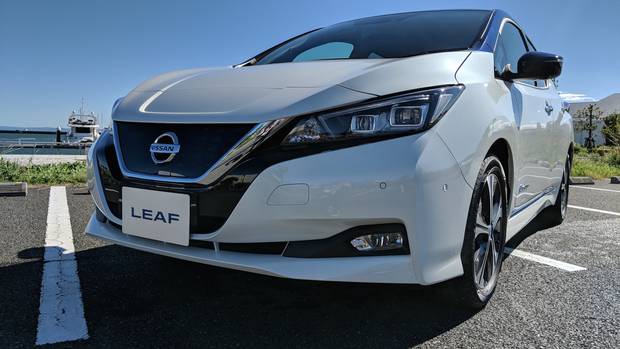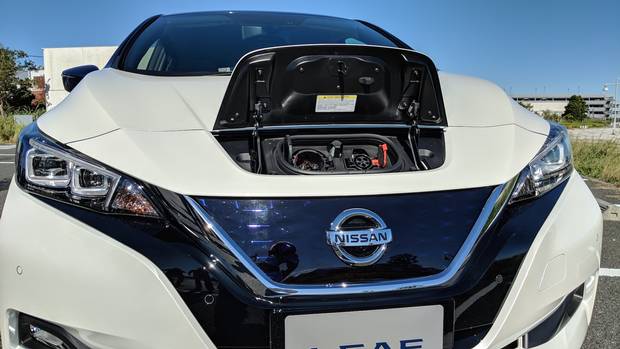It takes only a short time behind the wheel of the upcoming 2018 Nissan Leaf to get hooked on its single-pedal drive system.
The Leaf's e-Pedal all but eliminates the need for an actual brake by combining the electric vehicle's slowing and stopping functions with the accelerator. It seems like something that would require a steep learning curve, but it doesn't.
Instead, you quickly discover that easing off the gas slightly slows the car, while taking your foot away entirely decelerates and stops it.
It was an odd feeling at first to not be switching back and forth between accelerator and brake, or to be sitting at a stoplight without a foot on a pedal. But by the end of my half-hour test in advance of this week's Tokyo Motor Show, I found myself wishing my own car back home had the e-Pedal.
The new Leaf still has a dedicated brake, which will obviously be necessary for hard and sudden stops, but Nissan Motor Company Ltd. believes the single-pedal system is the shape of things to come.

With the single-pedal system, the Leaf slows when you ease off the gas. Taking your foot off the pedal stops the car.
"For many years we drove with three pedals and in the 1990s we graduated to two pedals, so now we're going to one pedal," says Francois Lefevre, chief marketing officer for electric vehicles at Nissan Canada. "You're not switching pedals, so it's very simple and it relieves that stress when you're on the road."
The Japanese car maker isn't the only manufacturer that supports the idea. Tesla is adding similar capabilities, as is Chevrolet with its electric vehicle, the Bolt.
In each case, the single pedal actually has a practical use beyond easing the amount of work the driver has to do. When the driver's foot isn't actively pressing down, the car is using its kinetic energy to recharge the battery.
That explains why the Leaf is the first Nissan car to get the e-Pedal, although it probably won't be the last. It could migrate to other vehicles including standard gas-powered cars if it proves popular with consumers, Lefevre says.
The e-Pedal is one of the marquee features of the new Leaf, which Nissan is targeting for launch in Canada in the first quarter of 2018 at a base price of $35,998, before incentives. The updated model is the second generation of the line that launched in 2010, and in Canada a year later.
The company says 280,000 Leaf cars have been purchased to date, making it the best-selling EV in the world, ahead of Tesla. That's a veritable drop in the total bucket – Nissan sells about 4,000 Rogue cars a per month in Canada, versus about 120 Leaf vehicles – but momentum is starting to build.

The 2018 Leaf’s range has been increased from about 172 kilometres to 241.
Better government subsidies on EVs and rapidly multiplying charging stations – approximately 4,550 across the country – means consumers are starting to bite in larger numbers. Leaf sales in Ontario, for example, have doubled since February, when the provincial government increased EV rebates to $14,000 from between $9,800 and $12,200, Lefevre says.
The 2018 Leaf also boasts a number of improvements over the 2017 model. The second-generation engine boosts horsepower to 147 from 107 and pure power to 110 kilowatts, from 80. A better battery also increases range by 40 per cent, from about 172 kilometres to 241.
Aside from e-Pedal, the 2018 Leaf is also the first Canadian car with Nissan's ProPilot Assist, available in the mid-level and high-end trim versions, which sell for $39,958 and $41,998, respectively. The 2018 Rogue will also have ProPilot as an option.
Activated by a button on the steering wheel, the system maintains the car at a constant distance from the vehicle in front of it and keeps itself centred in its lane.
With ProPilot engaged, you can take your foot off the pedals – or pedal, if you will – and technically let go of the steering wheel, although doing so provokes an alert. It's a step toward autonomy, but Nissan doesn't want your attention drifting from the road entirely.
"It's opening up the door to our autonomous driving experience," Lefevre says. "It also relieves stress because you're not constantly focused on the road."
North American versions of the 2018 Leaf will have one major difference from their Asian and European counterparts – no self-parking.
The capability worked well in my test, with the car automatically manoeuvring itself into a parking spot I picked on its touchscreen, but Nissan says its market research shows few Americans and Canadians are willing to pay extra for the necessary sensors.
The writer was a guest of the auto maker. Content was not subject to approval.
Shopping for a new car? Check out the new Globe Drive Build and Price Tool to see the latest discounts, rebates and rates on new cars, trucks and SUVs. Click here to get your price.
